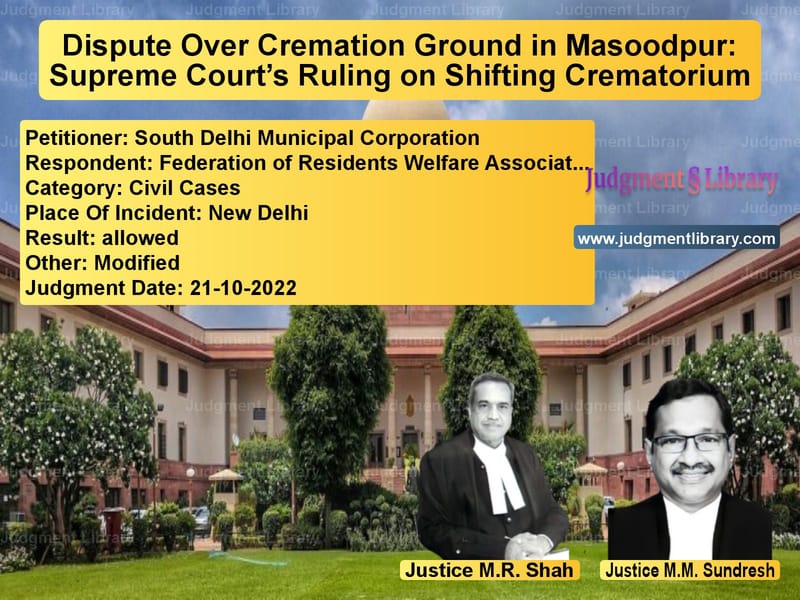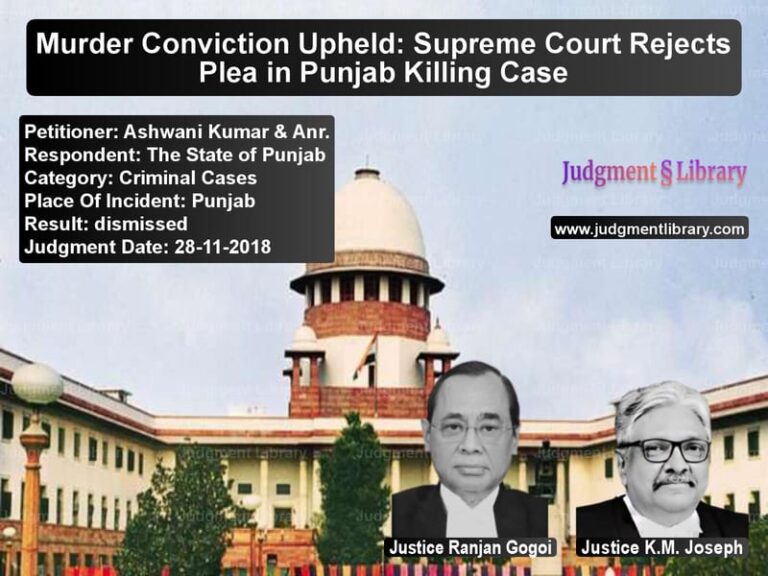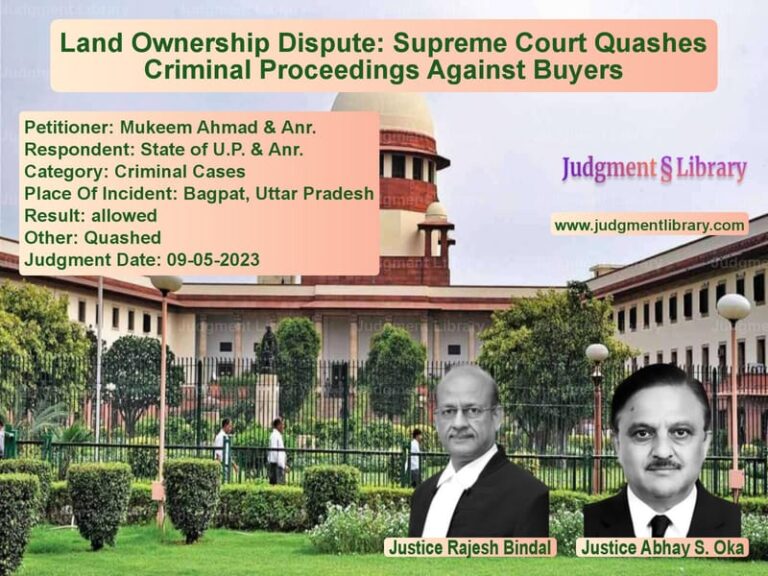Dispute Over Cremation Ground in Masoodpur: Supreme Court’s Ruling on Shifting Crematorium
The South Delhi Municipal Corporation (SDMC) filed an appeal against the decision of the Delhi High Court, which dismissed its application to modify an earlier ruling directing the closure and relocation of a crematorium at Masoodpur Village. The appeal, heard by the Supreme Court, centered on whether the crematorium, which had been in use for over a century, should be closed or allowed to remain operational given its long-standing service to the local village population.
This case involved a fundamental debate over the public interest, the rights of the local residents of Masoodpur Village, and the broader community living in areas such as Vasant Kunj, who were concerned about the proximity of the cremation ground to their residential complexes.
Background of the Case
The cremation ground in question has been serving the residents of Masoodpur Village for over 100 years. However, the issue arose when the Federation of Residents Welfare Association, Vasant Kunj, filed a writ petition seeking to stop the use of the crematorium at Masoodpur, arguing that it was located too close to their residential area. The Delhi Development Authority (DDA) had already proposed the establishment of a new crematorium at Kishangarh, about seven kilometers away, which was intended to replace the one at Masoodpur.
Initially, in 2003, the Delhi High Court directed the Municipal Corporation to take necessary steps to shift the crematorium to Kishangarh. However, in 2016, the Standing Committee of the SDMC, after considering the long-standing use of the Masoodpur crematorium, decided not to close it, arguing that its continued operation was in the public interest and that it served the local community. The SDMC’s decision not to close the crematorium led to the filing of the present appeal.
Petitioner’s Arguments
The SDMC, represented by senior counsel Ms. Vandana Sehgal, argued vehemently that the High Court’s 2003 decision to close the crematorium and relocate it was incorrect. The key arguments presented by the SDMC were:
- The crematorium at Masoodpur had been in use for many years and served the residents of the village long before the establishment of the Vasant Kunj residential colony in 1990.
- The SDMC, under Section 42 of the Delhi Municipal Corporation Act, 1957, was obligated to make provisions for the disposal of the dead, which included maintaining cremation grounds.
- The decision to close the crematorium was made without adequate consideration of the public interest, as it was being used by the residents of Masoodpur for over a century.
- The Municipal Corporation had a duty to ensure the continued functioning of the crematorium for the local village population and should not be forced to close it due to concerns raised by later residents of Vasant Kunj.
Respondent’s Arguments
The Federation of Residents Welfare Association, Vasant Kunj, represented by counsel Shri Karan Singh Bhati, opposed the appeal. The primary arguments put forth were:
- The crematorium was located too close to the residential complexes of Vasant Kunj, creating health and environmental hazards for the residents.
- The DDA had already allotted land at Kishangarh for a new crematorium, which was a more suitable location for such a facility, being seven kilometers away from the residential areas.
- The SDMC’s refusal to close the crematorium and move it to Kishangarh was not in the best interests of the local residents of Vasant Kunj.
Supreme Court’s Observations
The Supreme Court carefully examined the legal and factual background of the case. The Court noted the following points:
- The crematorium at Masoodpur Village had been in continuous use for over 100 years and served the local population long before Vasant Kunj was developed.
- The Delhi Municipal Corporation Act, 1957, required the Municipal Corporation to make provisions for places of disposal of the dead, which included the operation of crematoriums.
- It was crucial to balance the interests of the village population who had used the crematorium for generations and the newer residential areas like Vasant Kunj, which raised concerns about the proximity of the crematorium.
- The Standing Committee of the SDMC had made a conscious and well-reasoned decision not to close the crematorium, based on factors such as its long-standing use, the public interest, and the lack of significant health concerns arising from its operation.
Final Verdict
The Supreme Court ruled in favor of the SDMC, concluding that:
- The High Court’s earlier order directing the relocation of the crematorium was not appropriate, considering the long-standing use of the facility by the village people.
- The decision of the SDMC’s Standing Committee to not close the crematorium was justified, as it was based on public interest and had been made following due consideration.
- However, the Court directed the SDMC to modernize the existing crematorium at Masoodpur by shifting it to a more advanced electric crematorium, which would better serve both the village and the residential communities in the vicinity.
- The modernization of the crematorium must be completed within 12 months from the date of the order.
Conclusion and Implications
The Supreme Court’s decision emphasizes the need for balancing the rights and interests of different communities. In this case, the long-standing use of the crematorium by Masoodpur’s village population was given due consideration, while also addressing the concerns of the newer Vasant Kunj residents. The Court’s directive to modernize the crematorium reflects a forward-thinking approach to resolving such disputes by improving facilities to meet modern standards.
The decision also highlights the role of local governing bodies, such as the SDMC, in making decisions that impact public facilities and the importance of ensuring that such decisions are made in the larger public interest. The modernization of the crematorium will provide a more sustainable and efficient solution for both the village and the surrounding residential areas.
Petitioner Name: South Delhi Municipal Corporation.Respondent Name: Federation of Residents Welfare Association, Vasant Kunj.Judgment By: Justice M.R. Shah, Justice M.M. Sundresh.Place Of Incident: New Delhi.Judgment Date: 21-10-2022.
Don’t miss out on the full details! Download the complete judgment in PDF format below and gain valuable insights instantly!
Download Judgment: south-delhi-municipa-vs-federation-of-reside-supreme-court-of-india-judgment-dated-21-10-2022.pdf
Directly Download Judgment: Directly download this Judgment
See all petitions in Contract Disputes
See all petitions in Property Disputes
See all petitions in Consumer Rights
See all petitions in Judgment by Mukeshkumar Rasikbhai Shah
See all petitions in Judgment by M.M. Sundresh
See all petitions in allowed
See all petitions in Modified
See all petitions in supreme court of India judgments October 2022
See all petitions in 2022 judgments
See all posts in Civil Cases Category
See all allowed petitions in Civil Cases Category
See all Dismissed petitions in Civil Cases Category
See all partially allowed petitions in Civil Cases Category







